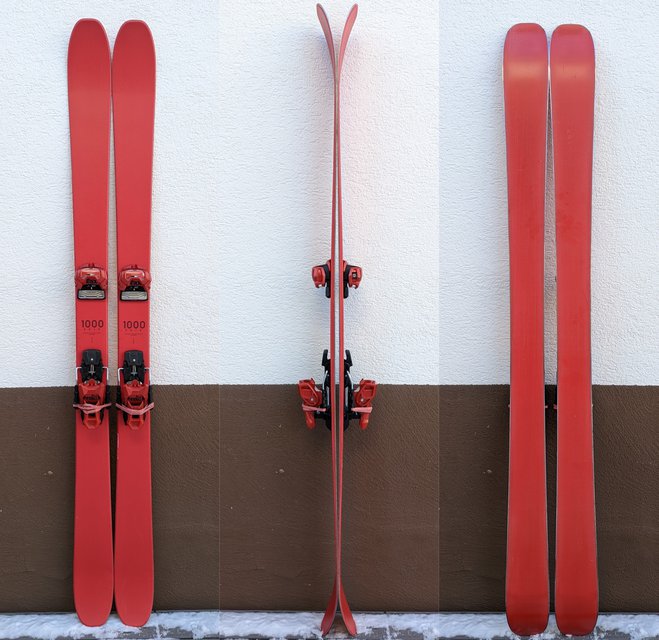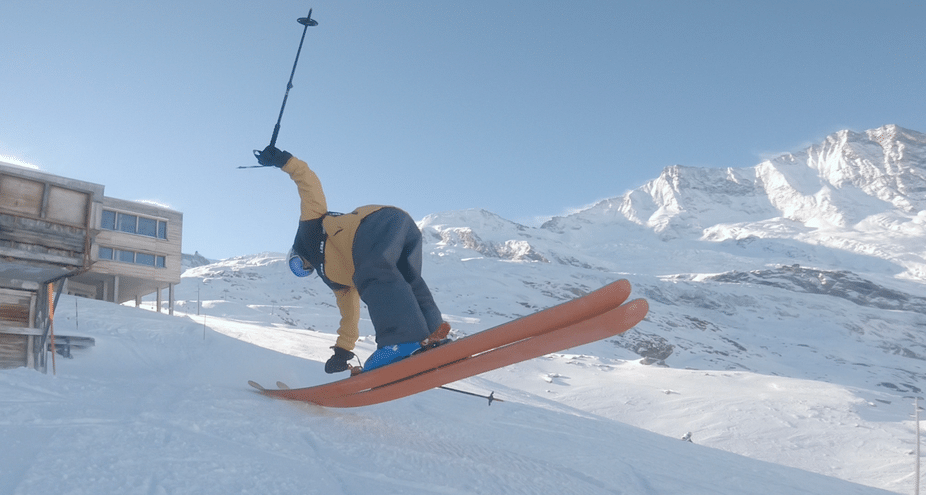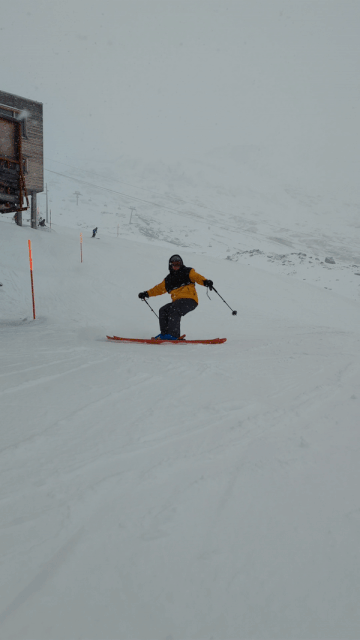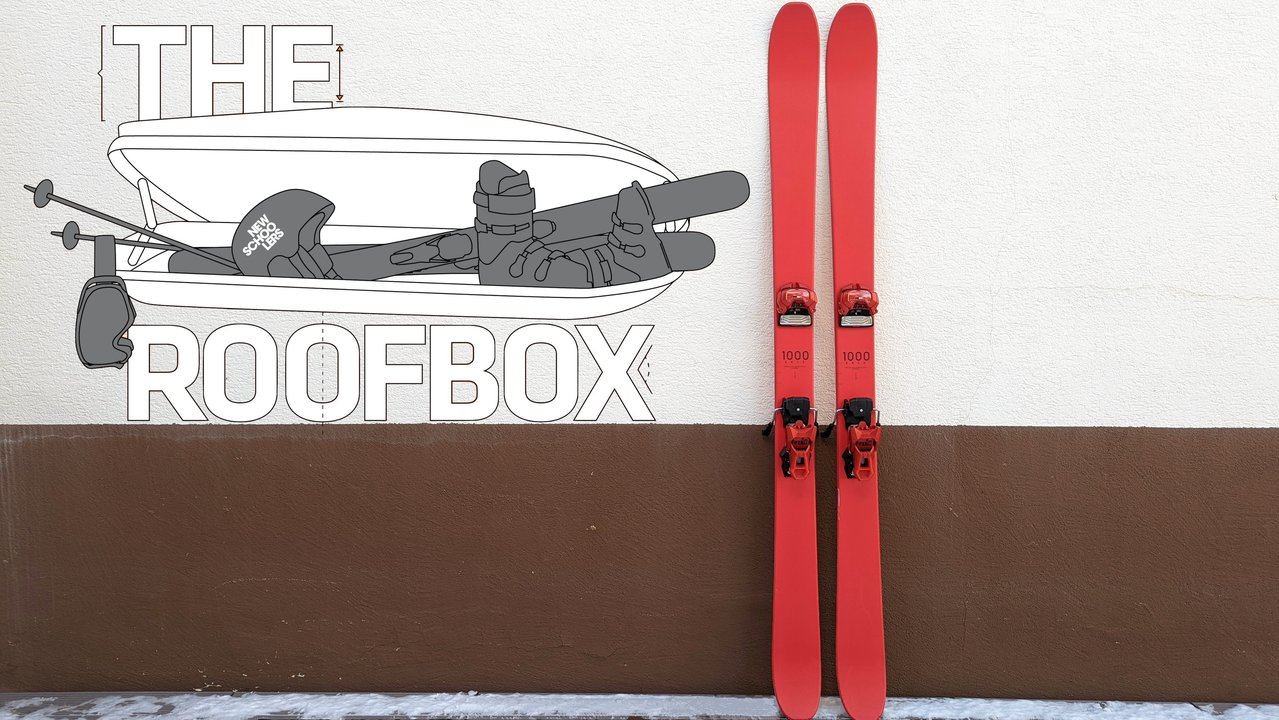Ski: 1000 Skis Park
Reviewer height/weight: 174cm / 68kg
Ski weights: 1652/1673g
Length skied: 171cm
Actual length (with straight tape): 172.1cm
Dimensions: 128 - 95 - 120
Radius: 17m
Mounted: -1.25cm from true center
Bindings: Tyrolia Attack 14
Locations: Saas-Fee
Conditions skied: Hardpack, ice, sidehits, crud, shallow pow
Days Skied: 12
_
1000 Skis have certainly made a splash in the ski game. Their rider ownership and sustainability-focused operation tick boxes that a lot of skiers have wanted to see ticked for a while now, and the bright red skis stand out amongst the crowd. I’ve had the chance to return to snow and to reviewing after my ACL tear last season on their new park model, and despite not skiing at anything like full capacity, I feel like I’ve had enough time and tried enough stuff on these skis to drop a solid Roofbox Review. It’s quite a long one, so I’ll leave this intro at that.
_
Shape/Flex/Construction
The 1000 Park has a fairly typical construction for a modern park ski. Wood core (poplar), a capped sidewall construction, and sintered bases. The plain red topsheet, which runs across all their models and will continue to do so for a far into the foreseeable future, is of the more modern textured kind. The skis have a fairly thin core profile despite and despite 2.3mm edges, weigh in at under 1700g per ski.

The shape of the ski is actually fairly traditional, 1000 certainly haven’t tried to reinvent the wheel here. There is only a slight rocker in the tip and tail (a little more in the tip, the tail is almost fully camber), with just a few mm of rocker splay. The rocker length does increase when you de-camber the ski, but I would describe these skis as largely cambered with a little ‘early rise’. The skis do have a pronounced tip and tail splay, more in the direction of traditional twin tips, and a full sidecut giving them a slightly ‘retro’ look compared to skis like ON3P, Vishnu, etc.
The flex of the ski is definitely soft both in terms of longitudinal flex and torsional flex. That flex is, however, much more even throughout the ski than most of what you see on the market today. Most skis are fairly stiff underfoot and softer in the tips and tails. In terms of flex, these are softer underfoot and immediately in front/behind of the bindings than most, but the tips/tails don’t really soften off as much as some.
_
A note on sizing and mounting:
I’m 174(ish) cm tall and about 68kg (150lbs) in my post-rehab pumped-up state (about 15-20lbs heavier than before my injury, thanks Men’s Journal!). I typically ski a 175-178cm park ski, but given the injury comeback and the fact that so many of the questions about 1000 Skis have revolved around their offering longer sizes, I opted for the smaller 171 lengths of the Park. Overall, I was happy with that decision. With full sidecut and almost full camber, and the fact that these skis actually measure longer than stated (172cm tip to tail) they felt just as long as the skis I’m used to using. I don’t think I would have wanted a 178cm ski in this shape as there would be a little too much snow contact for the shuffle-type tricks that I like to do.
I mounted mine at -1.25cm from true center (center and -2.5 are marked and I split the difference because that’s what Magnus told me he did). It feels like these have a relatively large sweet spot and would be comfortable anywhere from true center to -4cm depending on the skier and preferred stance.
_
On-snow performance:
The first thing you notice when you click into the 1000 Park is that it is almost laughably easy to ski. The low weight and soft flex, especially the torsional flex, make them incredibly easy to turn. I remember the 1000 crew talking about how they felt that most skiers out there were now skiing skis that are pointlessly stiff for their ability level. They weren’t just talking about park skiers, but also your everyday recreational skier out for a cruise. I have no doubt that they are right about that and that the Park, in particular, would be a very nice ski for an intermediate groomer cruiser.
They turn extremely easily but have enough camber to hold an edge on grippy groomers with no issue. The 17m (18m in the 178) radius is just on the short side of average and makes a variety of turn shapes very comfortably, I enjoyed these for mellow carving. Nimble is the description that 1000 use and I would concur with that. They aren’t lightning quick and edgy feeling like some of the new wave of fun carvers, but they are easy to make do most things. The ski has nice energy from turn to turn, but it’s so soft that it doesn’t rebound too much and feel overreactive. They aren't as easy to break loose (surfy feeling) as some park skis, but they are so light and soft that they do retain a pretty loose feel for a mostly cambered ski.

However, they are definitely soft and as with all skis, there is a tradeoff. There is a definite speed limit at which they feel comfortable and a snow hardness limit. Push these skis too hard, or ski too fast and you can flex through these skis and end up folding them through the turn. At that point, the not very rockered tips bite and things get a bit sketchy. In other words, they can be a bit ‘hooky’ even on hardpack. On ice, the lack of torsional stiffness just doesn’t hold up, though the longer cambered length helps counterbalance things somewhat and they do better than skis with extreme rocker, especially with dull edges.
The fact that I skied the 1000 Park back to back with the Season Kin, which is ridiculously grippy and rips groomers, probably didn’t help my impression here. So for clarity, these are far from the main offenders. The Blend, which is probably the closest direct comparison to these skis, is worse in this kind of conditions. Skis like the BDog, Wet, Vacation, which are both soft AND heavily rockered are worse again, especially when detuned.
You aren’t buying these for soft snow, and 1000 Skis aren’t trying to sell them for that. But with minimal rocker they are far from the best soft snow ski in this width category. The soft flex does help with float but a lack of any early taper, a 95mm waist and relatively mellow tip rocker does not equal a great shape for pow skiing. It almost goes without saying that they deflect a lot in chop/crud, but they do.
So in terms of on-snow performance, these are a somewhat mixed bag. There is a speed limit, but they turn really well and they’re a lot of fun on grippy snow days. They’d make an amazing ski for an intermediate skier out cruising, even if they had no interest in jibbing. Why did we stop making skis that tick that box by the way? Everyone’s dad used to have a pair of twins for cruising around and I feel that venturing into such specific jib ski shapes killed the park ski market. The 1000 Park is definitely a step back in the opposite direction and they are impressively versatile for the flex.
_
Park/Jibbing:
Let’s start with the obvious points; these are one of the easiest skis to butter out there. And by that, I mean actually butter properly by flexing the ski. You can achieve ‘buttering’ on a super rockered ski like ON3P or Vishnu by just sort of leaning on the rockered section without actually flexing the skis (though Vishnus flex easily too). But on the 1000s, you do actually need some technique. However, it’s very easy indeed to get up onto the tips and tails and because of the smooth flex profile, which doesn’t soften that much in the extremes of the tip and tail, they are still stable enough if you throw a bit more weight into the butter than you perhaps should have. Skis like the Wet and Blend are much easier to overpower, due to their rocker and super soft tips respectively.

This was literally the first nosebutter I tried with the new ACL
And once you’ve got these skis flexed, they play their trump card, POP. I think the 1000 Park is probably the poppiest ski I have ever tried, surpassing the bamboo core version of the Line Honey Badger. That pop comes from a combination of factors: The soft flex makes it easy to load the ski, the camber means the core wants to snap back into shape, and an energetic core/layup adds the final ingredient. I am far from my strongest in terms of power at the moment, but I found these super low effort to ollie over small fences and other obstacles.
Unfortunately, we still don’t have a park in Saas-Fee at this point, and my knee isn’t ready for street spots, so I haven’t hit any rails on these. I will come back and update this review if the rail performance throws up any surprises but the flex will certainly make these very comfortable for all kinds of butters and presses onto rails. And the more cambered shape is something I generally find really helps with gripping on 5050 tricks on wide tubes. @milo-mcsenderson skied a bunch of park laps on them too, and you can find his take here.
"I found the 1000 Park insanely light as well, quick to manoeuvre and easy to flex. I mainly rode them on rails and jibbing, they were easy to swap, butter and play on and I felt they were really at home doing this. The energy out of butters and presses from these is insane and this translated somewhat to few disasters which I found them more than stable enough for. I had a heap of fun on these especially compared to heavier longer skis I rode, Fauna Omni and Faction Prodigy 1.0, these definitely felt like less 'work' and an easy ski to have fun on in the park. " - @milo-mcsenderson
Due to the same ‘lack of park’ issue, I haven’t hit any park jumps on these either, but luckily there are plenty of sidehits and gaps ranging from small to large around, and I’ve been able to throw a range of basic tricks off these and go big enough that I do feel comfortable talking about stability and swingweight.
Said swingweight is low, simple as that. These are shorter than I usually ski, which I’m sure plays a role in that, but the skis are incredibly light which is definitely a bigger factor. In fact, these are probably the lightest ski to spin that I’ve tried recently (again, perhaps since the Honey Badger). At the same time, the close to full camber profile makes them surprisingly stable on landings. They obviously aren’t a full-on jump ski, but I would say about equivalent to the Armada EDollo in terms of stability, and significantly more stable than the Blend, Wet, J Skis Vacation etc.

_
Durability:
Unfortunately, I simply can’t comment on durability with any reliability. I am not skiing hard enough that I’d expect any major damage to a ski in 10 days of skiing and these are looking pretty fresh. There are a couple of topsheet dings and some normal base scratching but nothing to remark on. When mounting, the screws bit well and the core felt solid. The build looks good and the Swedish factory (Åreskidfabrik) in which they are built has a good reputation but that is about all I can say here.
_
Comparisons:
Vs Line Blend
The closest ski to the 1000 Park is undoubtedly the Blend. Sure the Blend is 5mm wider but shape has similarities and they both use flex, rather than rocker profile to be ‘playful’. But I personally find the Blend’s flex profile, which is actually stiffer underfoot than the 1000, but softer tip and tail to be ‘too unstable’. Whereas the 1000 just toes the line of stable enough for me. And it has a lot more pop. Which given that Peyben was heavily involved in designing these, isn’t surprising. These feel something like a Blend Plus if you will, slightly more energetic and stable but with similar DNA. Then again, the Blend is still even easier to butter/flex, there’s always a tradeoff.
Vs Volkl Revolt 95
The Revolt has better torsional stiffness than the 1000, and it’s a bit stiffer, which makes it a superior hard snow ski in my opinion. But the more cambered tail of the 1000 means they end up feeling a little more stable on landings to me, and they blow the Revolt away for buttering, jibbing etc. They’re also just more fun.
_
Conclusion:
Ski reviewing is hard. Not because of the testing; taking skis out and putting them through their paces is about as fun as work gets. But I worry about the results of my words. By virtue of the size of the Newschoolers’ platform, these reviews can have a genuine impact on sales. Our aim has always been to be as honest as possible but that can, on rare occasions, make or break a product. For me, that feeling of worry reached a fever pitch with this review because the guys behind 1000 Skis are my friends. I would genuinely like to tell the world these are the perfect ski for everyone, no matter their preference and help them sell out their inventory in seconds. Alas, there is no such thing as the perfect ski, but I had a great time on the 1000 Park and I do think they will make a great choice for a lot of you out there.
The 1000 Park takes a different route to jib ski territory from most. It recalls older park skis, with its mellow rocker lines and near full sidecut. Because of this, the ski is a much more accessible shape for ‘normal skiers’. My dad could jump on these and enjoy them, and that would certainly not be the case on more extreme park shapes like the BDog or Vishnu Wet. Meanwhile, the soft flex and core energy make them almost as good for The Bunch's style of skiing as more specialized shapes. But with these, you are trading looseness, and the ability to essentially cheat at buttering for a more useable shape as a daily driver.
For me, that puts these in the same marketplace as the Blend and the Völkl Revolt 95, which I think is what 1000 were aiming for. Their own marketing description describes these as buttery and nimble, and that they certainly are. But they do have limits: they aren’t really for charging, huge jumps, or icy days. They are, however, ridiculously accessible for a majority of skiers and could find a home in most quivers as an “easy day out” kind of ski. And above all they are a buttery, super lightweight park tool with a ridiculous amount of pop. The crew designed these for people who want to ski as they do, and for that, they do a fantastic job.


Comments